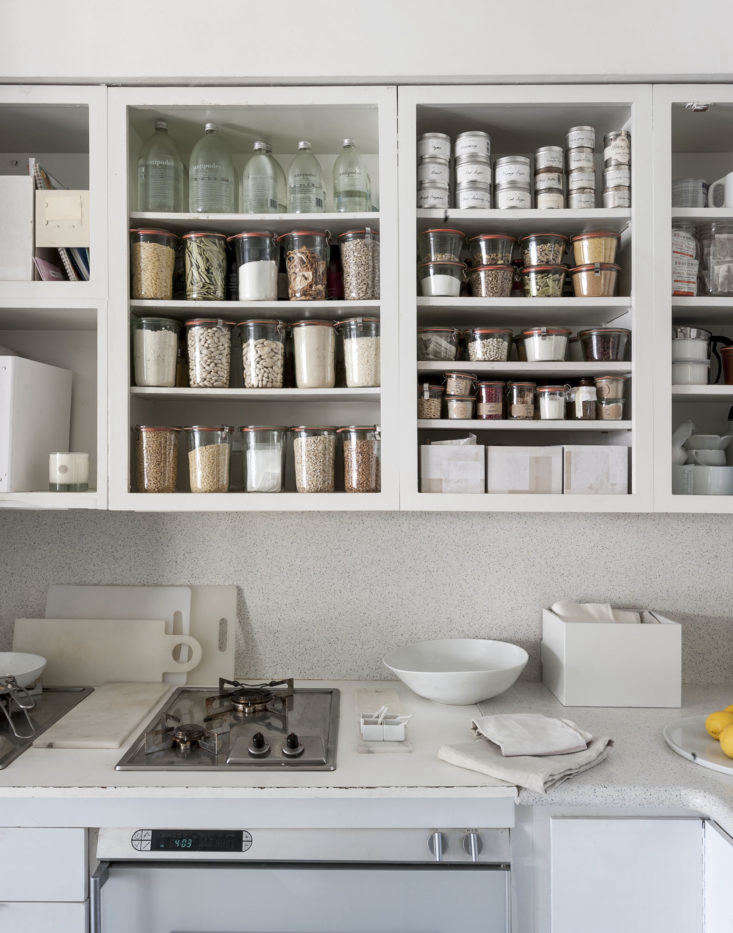
Ever since we launched The Organized Home, we’ve extolled the virtues of storing grains and dried goods in glass jars. The pluses are many: Decanting makes it easier to see and access what you have, and—not for nothing—results in a pantry that’s aesthetically pleasing. (See The Organized Pantry: 8 Rules for Decanting Dried Goods and The Organized Spice Drawer: 8 Rules for Decanting Kitchen Spices for more reasons.)
Trouble is, I didn’t listen to our own advice. Perhaps you feel as I did: “Decanting is too high-maintenance for me.” “I don’t care how my pantry looks.” Or, “I’ll get to it someday.”
But I’m reporting in from an apartment strewn with sticky traps, my belongings tied up in trash bags, to tell you that decanting is worth it for yet another—perhaps most compelling—reason, and that reason may be lurking in your bag of flour and laying eggs in your cake mix.
Read on for my cautionary tale.

The story starts several months ago, when I started noticing tiny, sprinkle-sized bugs with six legs and prominent antenna roaming my New York City apartment. The sightings were sporadic, at first. I’d be working at my desk and notice one crawling on the white wall. Or I’d get out a cutting board to make dinner and find one on the wood. Admittedly, I didn’t think much of it: New York apartments come with bugs, and these seemed harmless and few and far between. At least they weren’t cockroaches.
But the situation took a dire turn three weeks ago when I was setting the table for a quiet Saturday night dinner in with my boyfriend. I lit a candle, opened a drawer to get out cloth napkins, reached in, and unearthed dozens of bugs crawling around the fabric. It was like something out of a David Lynch film. I took the entire drawer out, held it at arms length, crossed the apartment in three paces, and dumped it into the washing machine.
The next day, I was finding bugs on the kitchen countertops, in the cracks along the baseboards, in books, in my bed. I tried to put on a pair of pants and three live bugs fell out. I called the exterminator. But it only got worse from there.

What are flour bugs?
Some late-night, ill-advised Google sleuthing identified the bugs as something I’d never heard of: flour beetles (visual here), more specifically known as red flour beetles or confused flour beetles (two similar but different types of beetle). These bugs lay their eggs in dry goods—usually flour, but also cereals, pastas, and cake mixes, and even chocolate and pet food. Often, the grain is already infested when you take it off the shelf at the store, and it’s readily apparent that something’s wrong; the flour will have an off color or smell, or you may see live bugs.
In my case, the exterminator quickly determined the cause: three bags of flour a former roommate had left behind, in the far reaches of a top cabinet. And the bugs have had plenty of time to roam.
Why are flour bugs a problem?
Flour bugs are a nuisance but rarely a big problem. They’re small, they don’t bite, and, if caught quickly, they’re usually confined to one package of flour. But they can chew through paper, plastic, and cardboard and, left unchecked, can contaminate an entire pantry, leading to a huge amount of wasted food and money. Or, in my case, they can infest an entire apartment, and you may find yourself sleeping with a spray bottle of cleaning solution next to your bed.

How can you prevent flour bugs?
In all my late-night research the past few weeks, I’ve learned a few lessons I wish I’d known before. Follow these five steps to help prevent flour beetles:
1. Inspect flour and other grains as soon as you get home from the store.
Things to look for: gray or off-colored flour that may have an odd smell, visible bugs or larvae, or even tiny holes in packaging. If you see any sign of an infestation, quickly seal the package in a plastic bag, throw it away, and take out the trash. If the package has been in your pantry already, check around for other infested products. If there’s any chance, pitch it (then wipe out and vacuum shelves).
2. If everything looks okay, decant right away.
Store your dry goods in recycled, thoroughly washed and dried jars, or buy new ones (a few of our favorites here). I’ve decanted my coffee into re-purposed ball jars and ordered an Ikea 365+ Glass Jar with a tight-fitting rubber seal for storing the granola I’m addicted to—no bugs allowed.
3. Know what’s in your pantry.
Check your pantry and cabinets for old packages you may have forgotten about and throw them out. Keeping tabs on what’s in your pantry is a sure way to prevent flour bugs.
4. Buy only what you need.
Buying grains from the bulk aisle is a good way to cut down on wasteful packaging, but make sure you’re not buying more food than you need at a given time. Buying smaller amounts makes it easier to surveil for bug activity, and less likely that it will sit on your shelf too long. (Plus, it’s a good practice for minimizing food waste.)
5. Practice pantry maintenance.
Regularly wipe or vacuum shelves. Decanting grains into jars makes it easier to empty out your pantry or cabinets and wipe out shelves and drawers completely. A frightening fact: Flour beetles can survive off of even the tiniest bit of spilled grains or flours.

N.B.: This post is an update; it was first published in 2018.
In case I haven’t convinced you, here are more reasons to decant (plus tips and tricks):






Have a Question or Comment About This Post?